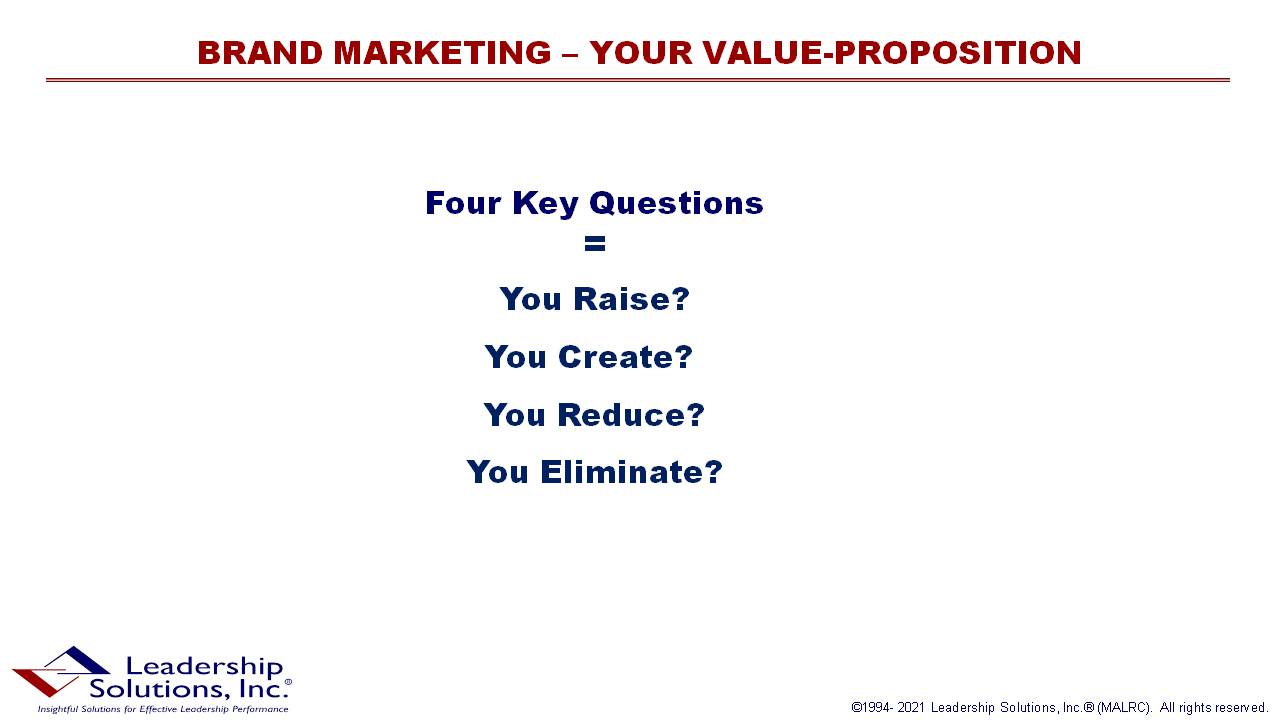by Peter A. Arthur-Smith, Leadership Solutions, Inc.®
“Positioning allows for regular adjustments along the pathway: planning sets a course that’s tough to change.”
Christine, from our recent Phase 1 article, ‘What are your Venture/Team Options for the New Year?’, chose to pursue Option D – Brand Marketing. She knew that would position her client leadership teams to find optimal pathways to fulfill their strategic visions. However, she also knew a sub-level option solving exercise called Peeling the Onion would be required by any teams to figure out their best Brand Marketing way forward…see www.optionsolving.com
Peeling the Onion would pose the question: What is any client leadership team’s best option for pursuing Brand Marketing? Any leader team she was associated with would therefore utilize two “sub-bookends” to help unearth their most realistic sub-options. These could include:
» Option AA – Copy successful competitors
» Option BB – Hire an appropriate marketing specialist
» Option CC – Develop an insightful ‘value proposition’ – ergo “brand” features
» Option DD – Put its leader team through a short marketing course
» Option EE – Update its current brand marketing efforts
» Option FF – Upgrade leader team to gain due strategic thinking support
After some thought and an appropriate anonymous team poll, Christine found that teams would typically decide upon pinpointing their company’s value proposition option (CC). This would often be based upon the way she illuminated the importance of discerning their company/team’s value proposition; specifically in the eyes of its current or future customers. Most of her client leader teamshave typically felt that such a value-proposition would mirror their company’s “brand”, as well. Are you already aware of this mirror connection?

However, through Christine, they also quickly came to comprehend that their vital value-proposition was not something to be dreamt up on a whim. It would require some serious thought and dedicated time by both the company/team leader (Visionist) and themselves. Christine was usually willing to act as a listening post while any Visionist led his/her team through the value-proposition scenario. She would encourage them to ask four insightful questions:
» What do you reduce for your customers?
» What do you eliminate for your customers?
» What do you create for your customers?
» What do you raise for your customers?
Take the example of one of her clients – a sizable, local car dealership. The overall dealer-leader (a Visionist named Joy) pulled her leadership team of six together for an initial half day. Under Christine’s watchful eye, it took initial stabs at these four questions by splitting into three “pairs” – because complementary pairs are far more productive than “lone thinkers.” They reconvened four times to share their thoughts on each question, and then compare notes to reach a provisional consensus. Their first blush efforts looked like this:
| » We Reduce » We Eliminate
– Wait times for new cars – Possible car damage – Unnecessary paperwork – Body scratches – Number of vehicle servicings – Unnecessary pollution – Engine noise – Wait times in showroom NOTE: Where necessary, done in conjunction w/car maker |
| » We Raise » We Create
– Standard of servicing – Better navigation system – Warranty terms – Better air conditioning – Passenger comfort – Hands-free communication – Inspection quality – Roadside assistance network NOTE: Where necessary, done in conjunction w/car maker |
Christine felt good about their preliminary listings: all important to their “customers.” They then agreed to meet for further two-hour meetings on the same day for the next consecutive three weeks. This would allow for continued subconscious thought and further ad-hoc discussions among team members during each interval. How much ad-hoc discussion do you imagine occurred during each meeting interval?
By their fourth week, Christine returned to admire their fascinating listings; some were quite a bit longer than others. At this juncture, Joy challenged each pair to discretely determine their top three items for each listing. After about forty minutes they reconvened to compare notes and, after due mixing and matching, they reached an overall consensus. Their twelve designated items now represented their dealership “brand.” From here they held intense discussions with the dealership’s sales and servicing teams to hear their thoughts and make further adjustments…without the buy-in of these teams, such efforts wouldn’t have particularly strong legs.
Out of this outcome they created the following marketing announcement that began to spell out their dealership brand, along the lines of:
| » We are your local dealership that minimizes wait times for your new car. We feel confident that your new vehicle will be undamaged in every way. Additionally, you will have a first class navigation system… |
Such a wholehearted statement was appropriately made available to customers and staff alike. Every month for the next six months every team took the opportunity to review and discuss this statement. So now their dealership was better positioned than ever before to pursue its chosen pathway with everyone on board.
